Fr. Joseph Verbis Lafleur
U.S. Army Chaplain, POW, KIA
By James G. Fausone
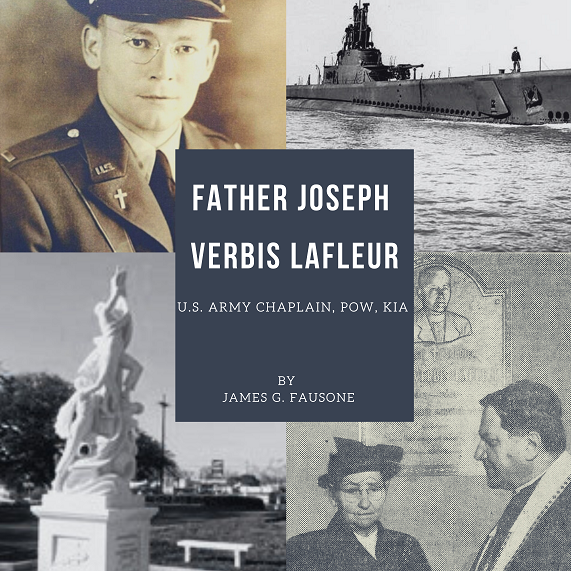
In January 1912, there was no reason to suspect the boy that was born in Ville Platte, Louisiana would grow up to be memorable, let alone remarkable.
Ville Platte sits in the middle of the State in Evangeline Parish. The French name translates to “flat town” and is not particularly noteworthy. The railroad came through Evangeline Parish in the early 1900s and Ville Platte swelled to 603 people by 1910. By the 1920 census, the town had grown to 1,350 people.
The Formative Years
A few strong influences existed in Ville Platte in the early 1900s and still exist today - French/Cajun culture and the Catholic Church. It is believed the town was founded by Marcellin Garand, an adjutant major in the army of the French empire under Napoleon. There are records from 1824 that show Garand obtained one of the first two lots surveyed and platted in what is now Ville Platte. The major operated a store and a tavern in town which was a stopping place for travelers traveling from Opelousas to Alexandria, Louisiana. Eighty-eight years after the founding by a military man, another would be born in that flat town destined for the military.
Joseph Verbis Lafleur came into the world the fourth child of seven of a loving mother Agatha Dupre and an absent father, Valentine Lafleur. In Joseph’s early childhood, the family moved to Opelousas, about 20 miles from Ville Platte. In 1920, it had a bustling population of 4,400 and as the seat of St. Landry Parish, it would have had greater work opportunities. Valentine ultimately abandoned the family leaving Agatha to eke out a living by doing odd jobs to support the seven children. Opelousas was an agricultural area that boasted growing spices and seasonings. It is a small, poor city even today but has always had a generous spirit that would have impacted young Joseph.
This was a time of World War and the Spanish Flu. The fighting started in Europe in 1914 and after numerous attempts to stay neutral, but pushed by German U boats sinking merchant ships, the United States joined the war effort in April 1917. Young Joseph would have been just 5 years old, an impressionable age for a young boy who would have been playing soldier with his siblings and friends in Ville Platte. By the time he reached the age of 10, the world was suffering from a pandemic commonly referred to as the Spanish Flu of 1919. WWI saw 320,000 U.S. citizens killed or wounded and the flu killed 675,000 citizens. The deaths from the war worldwide are estimated at 8.5 million and about 50 million died from the H1N1 flu virus. Between the war and the flu, it was a difficult time and certainly shaped the view of good and evil for Joseph Verbis Lafleur.
If war and disease were not enough, the heavens opened and the rains came to the region. In May 1927, Opelousas accepted thousands of refugees following the Great Mississippi Flood of 1927 in the Mississippi Delta. Heavy rains in northern and midwestern areas caused intense flooding in areas of Mississippi, Arkansas, and Louisiana downstream, especially after levées near Moreauville, Cecilia, and Melville collapsed. More than 81% of St. Landry Parish suffered some flooding, with 77% of the inhabitants directly affected. Over 5,700 refugees were registered in Opelousas, which had a population of only 6,000 people.
After the war, disease, and floods, the New York City social services agencies resettled Catholic orphan children by sending them to western rural areas, including Opelousas. At least three Orphan Trains reached this city before 1929. Catholic families in Louisiana took in more than 2,000 mostly Catholic orphans to live in their rural farming communities. For a young man of 17, Joseph had seen a lot of suffering in his world.
Like the rest of America in the early 1900s, not all men were created equal under the law. Discrimination in various forms, including worship, was a stain on the country and in Opelousas. The Catholic faith in the area goes back to the first resident priest, Capuchin Friar Valentin. in 1764. Discrimination impacted St. Landry Catholic Church where the Lafleur family practiced in 1920. Segregation at St. Landry led local Black Catholics to establish their own parish, Holy Ghost which grew to become one of the largest Black Catholic parishes in the United States.
With the world swirling in chaos, Joseph begged his mother and parish priest to allow and help him study for the priesthood. His parish priest, Father Colliard, made arrangements for him to enter St. Joseph’s Minor Seminary in St. Benedict, Louisiana in 1927. At the age of 15, he started down the path that would lead him to the U.S. Army Chaplain Corps. For 11 years, he prepared for the priesthood at St. Joseph’s Seminary and at Notre Dame Seminary in New Orleans, Louisiana. He was pious, studious, and an athlete on various seminary teams. He was ordained as a priest on April 2, 1938. He celebrated his First Solemn Mass at his home parish, St. Landry Catholic Church, in Opelousas, Louisiana on April 5, 1938, at the age of 26.
A New Priest Volunteers
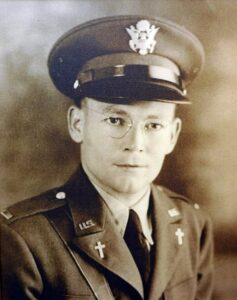 Father Lafleur’s first diocesan assignment was St. Mary Magdalen in Abbeville, Louisiana. The new priest was active in organizing youth activities and sporting events. Within three years of parish ministry, he wanted to join Army Air Corps. His initial request to his Bishop was denied. This request was made in 1941 when Europe was again at war starting in 1939, but before the United States was drawn into the war by the attack on Pearl Harbor on December 7, 1941. He explained volunteering because “all those other men being drafted had no choice.”
Father Lafleur’s first diocesan assignment was St. Mary Magdalen in Abbeville, Louisiana. The new priest was active in organizing youth activities and sporting events. Within three years of parish ministry, he wanted to join Army Air Corps. His initial request to his Bishop was denied. This request was made in 1941 when Europe was again at war starting in 1939, but before the United States was drawn into the war by the attack on Pearl Harbor on December 7, 1941. He explained volunteering because “all those other men being drafted had no choice.”
Father Lafleur was first assigned to an airbase in Albuquerque, New Mexico. The airbase was used for training and closed in 1944 merging into Kirtland AFB. Father Lafleur would have felt comfortable in Albuquerque, a community with a strong Catholic presence.
His next assignment was even farther away from St. Landry Parish. Fr. Lafleur was sent overseas. The Philippines were considered to be of great strategic importance in the Pacific Theatre to the U.S. As a result, 135,000 troops and 227 aircraft were stationed in the Philippines by October 1941. In early December 1941, Fr. Lafleur arrived at Clark Field, Luzon, the largest of the Philippine Islands.
He was on the base on December 8, 1941, when the Japanese attacked Clark Field as part of its strategy to degrade U.S. air and sea power in the western Pacific Ocean. This attack, following success at Pearl Harbor ten hours earlier, was focused on Luzon because of its long association with the U.S. military and strategic importance to the U.S. air and naval forces in the region.
As far back as 1899, Major General MacArthur (father of General Douglas MacArthur) established his headquarters near what would become Clark Field. This area became the cradle of pre-war American Army bases and airfields in the Philippines.
In December 1941, General Douglas MacArthur was the top U.S. military commander of forces on the island. The American military seriously underestimated the Japanese which resulted in the elimination of most of the U.S. Army Air Forces on Luzon in the first strike on December 8, 1941. The initial air attack significantly degraded the air power on Luzon. Of the seventeen B-17s on the ground at Clark Field, twelve were destroyed, four were damaged, and one escaped damage. Thirty-four P-40s were destroyed on the ground or in aerial combat.
The Japanese then landed at selected targets in northern Luzon to establish air bases closer to the objective and kept the Americans off balance from that point on. The main landing in Lingayen Gulf on December 22nd was the prelude to a succession of events that ultimately led to the last stand on Corregidor and Bataan, and finally, the American surrender of the islands on May 6, 1942.
During the attack on Clark Field, Fr. Lafleur administered to the flock giving last rights, praying with and for the dying, and assisting the medics. His actions resulted in him being awarded a Distinguished Service Cross in 1942:
"The President of the United States of America, authorized by Act of Congress, July 9, 1918, takes pleasure in presenting the Distinguished Service Cross to First Lieutenant (Chaplain) Joseph Verbis Lafleur (ASN: 0-413997), United States Army Air Forces, for extraordinary heroism in connection with military operations against an armed enemy while serving as Chaplain in Headquarters Squadron, 19th Bombardment Group (H), FIFTH Air Force, in action against enemy forces during the first Japanese attack on a Philippine Island airport on 8 December 1941. Chaplain Lafleur worked among the wounded, removing them to safety, and comforting the dying. First Lieutenant Lafleur's intrepid actions, personal bravery, and zealous devotion to duty exemplify the highest traditions of the military forces of the United States and reflect great credit upon himself, the 5th Air Force, and the United States Army Air Forces.”
The citation further stated:
“For gallantry in action without regard to his personal safety. During the initial bombardment of Clark Field, Pampanga, P.I., on December 8th, 1941, in which more than 150 airplanes participated, and which lasted for one hour and thirty minutes, Father LaFleur went calmly among the wounded and dying administering religious comforts and solace, as well as assisting in their removal to shelters and to the hospital. This continuous service during the intensive attacks of the enemy dive bombers and strafing airplanes, under such exposed conditions when taking of shelter would not have caused censure, set an example of heroic conduct under combat conditions such as to under this non-combatant to the entire command and is consistent with the highest tradition for such personnel.”
Prisoner of War
Before the surrender of U.S. forces, General Douglas MacArthur was ordered to Australia. There was no reason to believe in late 1941 and early 1942 that the Philippines could be defended or that all troops could be evacuated safely.
Joseph Verbis Lafleur retreated with the troops to Mindanao. Indeed his acts of valor continued even in retreat. As stated in his second Distinguished Service Cross citation, while evading capture aboard the S.S. Mayton, Chaplain Lafleur was instrumental in saving three men who jumped overboard during an attack from a Japanese bomber. After the three men were rescued, he then assisted soldiers into lifeboats until he was the last man on the ship, denying his own chance to escape to Australia.
The citation award misspelled the name of this Philippine steamship which was privately owned by the Manilla Railroad Company before being requisitioned into military transport services. S.S. Mayon was named after Mount Mayon, an active stratovolcano on the island of Luzon. A popular tourist spot, it is renowned for its "perfect cone" because of its symmetric conical shape and is regarded as very sacred in Philippine mythology. Fr. Lafleur continued to demonstrate his perfect character on the S.S. Mayon adding to Philippine mythology.
By May 1942, the Philippines were surrendered to the Japanese and the capture of U.S. and Filipino troops occurred. Lafleur earlier refused a chance to be evacuated saying, “I shall stay here. My place is with the men.” That decision led to his spending 29 months as a POW of the Japanese.
Most of the 75,000 Filipino and American prisoners of war (POWs) captured by the Japanese at Bataan were forced to undertake the infamous "Bataan Death March" to a prison camp 65 miles to the north. About 30% of those captured, weakened by disease and malnutrition and treated harshly by their captors, died before reaching prison camps. Things only got worse in the camps - even the strong did not survive. The death rate at Philippine POW Camps was reported at 55%, far higher than the 4% death rate in German-run POW camps in western Europe during World War II and double the 27% death rate in other Japanese-run POW camps.
Fr. Lafleur became a POW for approximately two and one-half years including stays at POW Camps O’Donnell, Cabanatuan, Davao, and Lasang.
After the surrender of tens of thousands of American troops during the Battle of Bataan, many were sent to a Cabanatuan prison camp following the Bataan Death March. The Cabanatuan prison camp was named after the nearby city of 50,000 people (locals also called it Camp Pangatian, after a small nearby village). Up to 8,000 POWs were housed in this, the largest camp in the Philippines. The Japanese transferred most of the prisoners to other areas, leaving just over 500 seriously ill POWs in the prison. Around 27,000 Filipinos and 2,200 Americans died at Camp O'Donnell. The horrible conditions at these camps cannot be imagined today. The lack of food, nutrition, health care, and medicine resulted in thousands of deaths. The spiritual needs of the dying were met by chaplains like Fr. Lafleur. He, like many others, contracted malaria and refused medicine so it could be used by others who needed it more.
Lafleur was never a big man both in height and weight, he was average. His wire-framed glasses made him look studious and nerdy in today’s vernacular. Time as a POW always emancipates a man and subjects him to diseases caused by malnutrition, mosquitoes, and the elements.
The men in the POW camps tell stories of Fr. Lafleur sneaking portions of his food rations to those in the infirmary. He did this so often that one of the men, who was blind at that point from malnutrition, could hear footsteps and tell when Lafleur was approaching with prayers and pieces of food. The infirmary, or hospital as it was called by the camp commander, was called “zero wards” by the prisoners where you were sent to die.
Fr. Lafleur was guided by his religious education recalling the story in Matthew that when asked by a young man what he had to do to get into heaven, Jesus gave three instructions: “keep the commandments. . . sell your possessions and give the money to the poor. . . follow me” (Mat. 19:17, 21). This directive struck home with Lafleur, and he again took it to heart, ‘If you wish to be perfect, go, sell your possessions, and give the money to the poor, and you will have treasure in heaven.” (Matt. 19:21) Repeating his actions years before as a parish priest, Fr. Lafleur sold his watch and eyeglasses to locals to procure more food for his fellow prisoners. Lafleur was living his Catholic faith and gospel. Driving his spirit was the recognition, applied to his Lord and Savior, that “Greater love has no man than this, that a man lay down his life for his friends.” John 15:13.
The POWs including Fr. Lafleur were marched south to Davao which had been a penal colony for years. During the Japanese occupation period, it was taken over by the Japanese Army as a prisoner-of-war camp. About 2,000 Americans were held at Davao during the war. Prisoners were treated harshly in manners typical of most prisoners of war camps run by the Japanese during this period. To aid in his meager ministry he built a small illegal chapel which was called St. Peter in Chains. This chapel was used by Catholics and non-Catholics to seek faith, pray and attend daily mass.
One day the Japanese captors announced to the prisoners the beginning of a new project. Seven hundred fifty laborers were to be chosen from among the prisoners of war to clear jungle land on the island. This forced labor would be shipped to the work area. Chaplain Lafleur traded places with one of the men chosen for the job. After all, he told the others, the men would need a priest.
The last note home was written by Fr. Lafleur on the back of a label from a can of milk, it would be his final message. He gave the message to a Fr. Kennedy and said, “If we both return to the states, send it back to me. If I do not return it, please send it to my mother.”
The message read: “Dear Momma and all. I have just had a long conference with Chaplain Brown (the head Chaplain at the camp) and he is letting me go on the Lasang work detail. Momma, ever since I heard about this detail, I’ve had a feeling that something would happen and that a Chaplain should go. I’ve tried and tried to get this out of my head, but it is constantly there, and I feel that I should go. I do not have to go, but if I didn’t and something would happen, I would never go back to the States as I could never face any of you again. I would feel as though I had not done my duty. So that is why I am going. And it won’t be many more years before there will be two of us at the Alter. On that day, if I am here, I will give him my blessing. And if I am not, I will be with you anyway and I will have a reserved seat up in Heaven. I am sure Our Lord will let me roll back just one little cloud so I can look down. And from up there I will have a more beautiful view and a more perfect understanding of what is going on. So, until that day, may God bless all of you. Love, Verbis.”
It was clear in mid-1944 the U.S. mission was to retake the Philippines. General MacArthur said, “I shall return” and he desperately wanted to fulfill his promise. The war in the Pacific had finally turned. Allied forces focused on Mindanao, Luzon and retook the islands after fierce resistance. When American troops arrived at Davao penal colony, they encountered bodies of dead prisoners decomposing at the places of their deaths without having even been buried.
In advance of surrender on the islands, the Japanese Navy began moving POWs by ship. POW Lafluer was in the group moved by ship by his captors. One theory was these POWs would limit or slow American bombing of the homeland. To prevent the liberation of the prisoners in the Philippines, the Japanese established a system of sea transportation called “Hell Ships" by those being transported. These Hell Ships were ordinary merchant vessels used to transport the Allied prisoners from the Philippines to elsewhere in the Japanese empire. These vessels were so-called because prisoners were transported in inhumane and unsanitary conditions amounting to torture.
It is estimated that more than 126,000 Allied prisoners of war were transported in 156 voyages on 134 Japanese merchant ships. More than 21,000 Americans were killed or injured from "friendly fire" from American submarines or planes as a result of the downing of Hell Ships.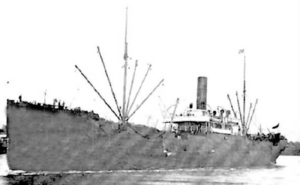
SS Shinyō Maru was one of these Hell Ships, she was a tramp cargo steamer directed by the Japanese in 1941 and crewed by both merchant sailors and Japanese soldiers. Shinyō Maru had carried rice and cement on its last voyage. It was then directed to transport, as reported in cables “something”, “evacuees” and “troops” from two Philippine ports. The Japanese soldiers manned the ship's machine guns and guarded 750 Allied POWs placed in the holds. The Shinyō Maru was sailing for Manila in convoy C-076 with 7 other vessels, including 2 torpedo boats, 2 tankers, and 4 other medium and small cargo ships.
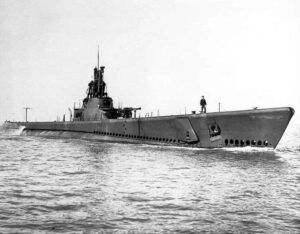 The convoy was spotted by the submarine U.S.S. Paddle off the coast of Mindanao on September 7, 1944. The Paddle believed the Shinyō Maru was carrying Japanese troops. Upon two successful torpedoes striking the Shinyō Maru was destined for sinking. The guards, designated men, opened fire on the prisoners in the hold.
The convoy was spotted by the submarine U.S.S. Paddle off the coast of Mindanao on September 7, 1944. The Paddle believed the Shinyō Maru was carrying Japanese troops. Upon two successful torpedoes striking the Shinyō Maru was destined for sinking. The guards, designated men, opened fire on the prisoners in the hold.
Ultimately, the POWs overpowered the guards and began abandoning ships. Father Lafleur refused to leave the ship when the men had the chance to climb out, instead of remaining behind to help the other men up the ladder from the hold. He joined his men in death. Of 750 Allied prisoners of war, 668 were killed. Those who made it to shore last saw Fr. Joseph Verbis Lafleur in waist-deep water, assisting others. His body was never recovered.
His heroic efforts on the Shinyō Maru were finally recognized in 2017 with the award of a second Distinguished Service Cross. The country’s second-highest award for valor, only the Medal of Honor holds more prestige, was again awarded posthumously:
"The President of the United States of America, authorized by Act of Congress July 9, 1918, takes pride in presenting a Bronze Oak Leaf Cluster in lieu of a Second Award of the Distinguished Service Cross (Posthumously) to First Lieutenant (Chaplain) Joseph Verbis LaFleur (ASN: 0-413997), United States Army Air Forces, for extraordinary heroism from 30 December 1941 through 7 September 1944. While evading capture aboard the S.S. MAYTON, Chaplain LaFleur was instrumental in saving three men who jumped overboard during an attack from a Japanese bomber. After the three men were rescued, he then assisted Soldiers into lifeboats until he was the last man on the ship, denying his own chance to escape to Australia.
As a Prisoner of War after 1 January 1942, Chaplain LaFleur constructed a chapel at the prison camp to minister to men of all faiths. He continuously advocated for food and medicine for the prisoners often intervening on their behalf, resulting in beatings at the hands of his captors. Later, while aboard the "hell ship" SHINYO MARU bound for Japan, he organized distribution of the meager rations allotted to approximately 400 prisoners and was observed giving his rations to others.
On 7 September 1944, the submarine U.S.S. PADDLE, believing the ship was transporting Japanese Soldiers, sank the SHINYO MARU. Chaplain LaFleur was last seen aiding prisoners to escape in spite of Japanese guards firing small arms weapons and throwing hand grenades into the ship's hold.
Chaplain LaFleur's personal valor and self-sacrifice in the face of grave danger are in keeping with the highest traditions of military service and reflect great credit upon himself and the Army of the United States."
A Faithful Man to the End
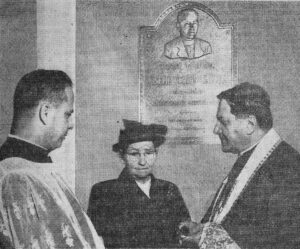 In his 2017 address at the National Catholic Prayer Breakfast, Archbishop for the Military Services Timothy Broglio recalled Lafluer as “a man for others right to the end.”
In his 2017 address at the National Catholic Prayer Breakfast, Archbishop for the Military Services Timothy Broglio recalled Lafluer as “a man for others right to the end.”
“He drew on his virtue to care for, protect, and fortify the men imprisoned with him,” Broglio said. “Many survived because he was a man of virtue who gave unstintingly of himself. To speak of the greatness of our country is to speak of men and women of virtue who gave of themselves for the benefit of all. We build for a new tomorrow when we draw from that wellspring of virtue.”
Fr. Lafleur’s home parish in Louisiana had a renowned Italian artist, Franco Alessandrini, carve in white Carrara marble a statue to commemorate this man of faith. The story of Father Lafleur’s life in marble depicts significant events in Father Lafleur’s 32 years of life.
Opposite the name engraving is a basso relief of Father Lafleur as Associate Pastor of St. Mary Magdalene Catholic Church in Abbeville, Louisiana. Among the youth, Father Lafleur was a great inspiration of faith in addition to being an avid sportsman. Depicted is Father Lafleur bringing baseball bats, gloves, and balls to the boys. He had purchased these bats, gloves, and balls by pawning his wristwatch. This giving of his personal possessions to help others was later repeated while a POW.
The third basso relief is of Father Lafleur’s time in the Philippine Islands. The final basso relief depicts the sinking of the prisoner of warship, Shinyō Maru, on September 7, 1944. It was where the “Padre” led his men in prayer, blessed them, and began pushing men up through the one escape hatch to the deck and to possible safety.
On September 5, 2020, the Diocese of Lafayette in Louisiana, led by Bishop J. Douglas Deshotel, officially opened Father Lafleur’s cause for beatification and canonization. In 2021, the Catholic bishops of the United States held a canonical consultation on the cause of beatification and canonization of the Servant of God Joseph Verbis Lafleur. The bishops expressed support for the advancement of the cause of beatification and canonization on the diocesan level. "Servant of God" is a title used in the Catholic Church to indicate that an individual is on the first step toward possible canonization as a saint.
The next step in the process to be declared a saint in the Catholic Church is to be declared venerable. Before a person is considered to be venerable, that person must be declared as such by a proclamation, approved by the Pope, of having lived a life that was “heroic in virtue”, the virtues being the theological virtues of faith, hope, and charity and the cardinal virtues of prudence, justice, fortitude, and temperance. In the Catholic Church, “The Venerable” is the title used for a person who has been posthumously declared, "heroic in virtue" during the investigation and process leading to canonization as a saint. That is followed by beatification, with the title of Blessed. After the confirmation of miracles resulting from the intercession of the honored, the final step is canonization, where the honored would receive the title of Saint.
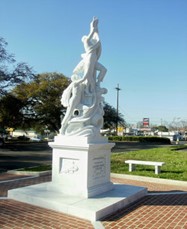
Fr. Lafleur is a Servant of God. No greater love has a man than to give his life for the good of others. Fr. Lafleur made that ultimate sacrifice for his men and for his God.
About the Author
Jim Fausone is a partner with Legal Help For Veterans, PLLC, with over twenty years of experience helping veterans apply for service-connected disability benefits and starting their claims, appealing VA decisions, and filing claims for an increased disability rating so veterans can receive a higher level of benefits.
If you were denied service connection or benefits for any service-connected disease, our firm can help. We can also put you and your family in touch with other critical resources to ensure you receive the treatment you deserve.
Give us a call at (800) 693-4800 or visit us online at www.LegalHelpForVeterans.com.
This electronic book is available for free download and printing from www.homeofheroes.com. You may print and distribute in quantity for all non-profit, and educational purposes.
Copyright © 2018 by Legal Help for Veterans, PLLC
ALL RIGHTS RESERVED



